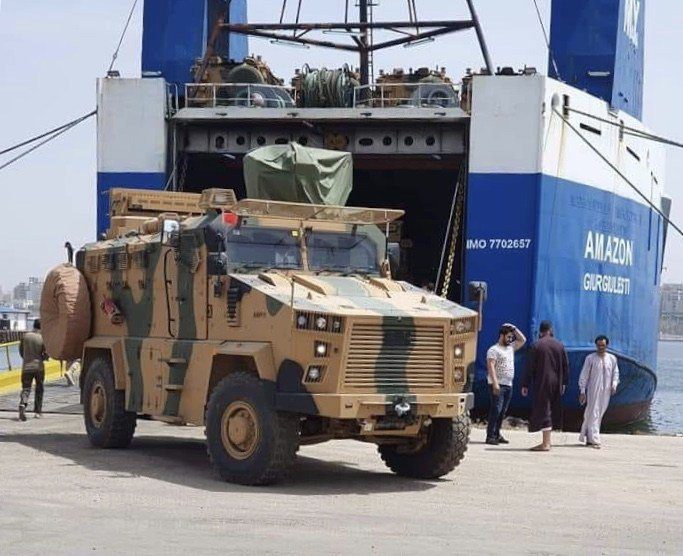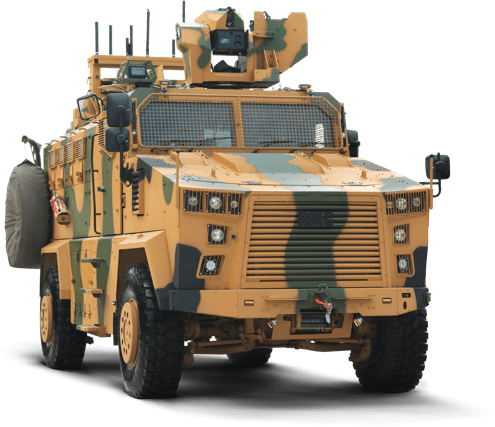Its not all the time that a belligerent in a war zone gets to conduct comprehensive tests on a major weapon system used by the opponent.
Be that as it may, this is what happened in Libya in January 2020, when soldiers of the Libyan National Army put to the test various captured Turkish-built BMC kirpi armored vehicles.
If the report of the KNA’stest is to be believed, then the BMC Kirpi performance is in the least “poor”.
In May 2019, forces allied with the U.N.-backed Government of National Accord (GNA) reported that they have received a large shipment of the Turkish-made BMC Kirpi armoured vehicle and arms.
The Government of National Accord published pictures on their official Facebook page, disclosing that they also received ammunition and “quality weapons”.
Dozens of the Kirpi vehicles were observed offloading from a ship, the shipment was through a vessel named “Amazon” that is registered in Moldova.

BMC Kirpi armoured vehicle (official data)
The BMC Kirpi (Turkish for “Hedgehog”) is a Turkish-made Mine-Resistant Ambush Protected vehicle (MRAP) built by BMC, its armoured hull provides protection against armour-piercing rounds and artillery shell splinters.
As an MRAP, The lower hull section is protected against grenades and landmines up to STANAG 4569 Level 3b. Its chassis is based on a BMC 4×4 truck model 235-16P.
It can be armed with a 7.62 or 12.7 mm machine gun on its small open roof cupola with fold-able protective walls or a remote controlled weapons system.
The Kirpi also features a shock absorber seats and interior accessories, a GPS system, rear view camera, and automatic fire suppression system. It has five firing ports and four bulletproof windows on each side of the troop compartment.
Report of the LNA tests on the BMC Kirpi armored vehicle
According to the report, it stated that: “A summary review done by the LNA on the Turkish armoured vehicle BMC.
This review was done after real combat in-theatre and furthe testing on captured models of BMC KİRPİ in Libya.“
Subsequently, the LNA made fourteen key negative findings and four other operational issues.
- WEIGHT: 19 tons with a maximum additional add weight of 1.5tons.
- SPEED: Maximum tested speed was (68 to 73Km/h ) although official data states 100km/h.
- ACCELERATION: The acceleration was found to be very low – from 0 to 45Km/h, which make it hard for quick escapes and rapid movements in small bursts.
- MANEUVERABILITY: The vehicles Angular maneuverability capabilities were “disappointing“, as the BMC KIRPI was unable to make sharp corners making it inappropriate for use in tight urban warfare, in which such terrains and obstacles are expected.
- VISIBILITY: The KIRPI visibility is insufficient as the driver and crew have limited sights, which the manufacturer (BMC) has tried to counter by installing cameras on the back front and sides, however, these can be easily disabled by dirt or mud from explosives. Making the driver blind in tight streets.
- TRANSMISSION: the Kirpi has 6 gears and 1 speed reverse, the gearbox has a maximum Torque of 1.5KNM @800-2100RPM. This figures were never reached in testing because, the gear box would to fail and leaks when such pressures are reached. As this happens the Gear Box seems to jump 3rd gear. Besides, when observed in combats situations it was clear that the BMC Kirpi choked and sometimes stall, the report suggests that this maybe due to inexperienced drivers. However, the issue of oil leaking was nearly constant.
- REMOTE WEAPON STATION: reaction time of the remote control of the mounted 12.5mm gun was very slow at 1.5 to 3 seconds from short to long shifts respectively. The gun could not shoot close targets from 2 metres to 3 metres unless the gunner uses it manually. The 12.5mm machine gun suffered from constant jamming, as the GNA soldiers were usually observed trying to unjam it during battle. Also, the chain lock fail safe was unreliable when ammunition ran out.
- SELF DEFENSE (ELECTRONIC WARFARE): helicopters jamming capabilities, were not working at all as it was easy to target them by Mi34 gunships
- SELF DEFENSE (INFRA-RED): IR only worked at certain angles.
- Central Tire inflation system: almost never works when tire is targeted.
- VEHICLE AXLE: the front axle of the BMC are extremely weak and fragile to explosives and even impact. It was observed in one case that a front axle was braking for no apparent reason during battle.
- ARMORED PROTECTION: the BMC has five vulnerability in its armor when targeted by a Rocket Propelled Grenade. A round can disable it or kill its crew
- FRONTAL ARMOR: the armored at the front wheels could be penetrated by an AK47 round (7.62x39mm).
- BACK DOOR: when targeted the back door becomes stuck and trapping the crew inside.
Other operational issues
- Getting stuck in mud.
- Doors locking and jamming.
- Electronics malfunctions.
- Engines over heating after long hours operation.
Conclusion
The report stated that the BMC Kirpi “is an effective weapon of terror but not for war. And that in facing experienced troops it becomes an easy target”
Experts criticize the LNA for poor combat capability
The Libyan National Army has also suffered criticism after several of its armored vehicles has been destroyed or disabled in battle.
In a apparent response to Turkey delivering dozens of the BMC Kirpi armoured vehicle to forces allied with the GNA, the Jordanian government has delivered an unknown number of its indigenous KADDB Al-Mared 8×8 armoured vehicle, as well as the Paramount Mbombe 6×6 armoured vehicle to Khalifa Haftar’s Libyan National Army (LNA).
Some of the South African-made Paramount Mbombe 6×6 armoured vehicle have been pictured either captured or destroyed. Just few days ago, several recent photographs released by the militants loyal to the LNA shows some Mbombe 6×6 vehicle with significant battle damages suggesting that it was hit by either a 23mm cannon or an anti-tank weapon.

These latest development suggests that despite fierce resistance, Khalifa Haftar’s forces are not quite as combat proficient as previously believed. Even though Russia, Egypt and the UAE currently supports the LNA because they consider Haftar to be a more viable option to defeat extremism than the U.N-backed GNA.





